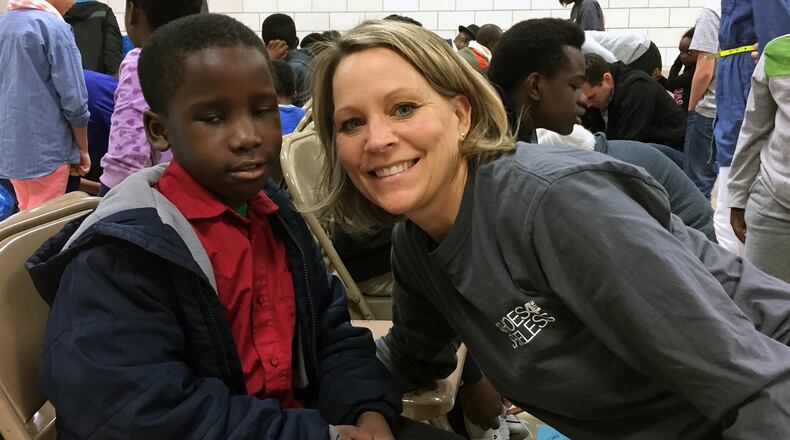“I knew all the caregivers for the kids,” Horlacher said. “And I asked if they had noticed the horrible condition of their shoes.”
To Horlacher’s surprise, she was told that yes, they had noticed that the shoes didn’t fit, were broken or worn, but that the children were “used to it,” and there were more pressing issues.
With many non-profits dedicated to helping feed, clothe and house the homeless and impoverished, Horlacher couldn’t understand why shoes were being ignored. So, within a week of her discovery, she said she felt compelled to find a way to put new, properly fitting shoes on the feet of all children in need.
“I did research and there wasn’t anyone addressing this problem,” Horlacher said. “I pulled together the kids from UD (University of Dayton) who had been volunteering for my mentoring program and asked them to help.”
Though Horlacher said she had no idea how to begin, she talked to several school nurses and principals and they verified that the need was great for shoes and socks. They all said, “I hope you fix this, because no one else has.”
Through trial and error, Horlacher and her group discovered that they couldn’t just collect donations and drop off shoes.
“We took our first 17 pairs of shoes to Meadowdale (high school) and none of them fit,” Horlacher said. “I learned that you can’t ask the kids what size they wear because no one knows.”
Over the years, Horlacher has perfected the process of putting properly fitting, new shoes on children’s feet. She worked with her volunteers to make a measuring device that was portable. And she knew almost from the onset that all volunteers should be paired one-on-one with children, working until they found the perfect pair of shoes.
Today, Horlacher drives a large truck, branded with their name, that has become a mobile shoe store of sorts.
“Kids come in and we measure their feet, put clean socks on them and try on shoes until they find a pair they like,” Horlacher said. “We have helped more than 55,000 kids with brand new shoes and socks and even new underwear.”
Local schools call all through the school year, asking if Horlacher and her team will come bring shoes for the children. She estimates they give away between 800 and 1,000 pairs of shoes each month between August and May. In the summer, that number drops to around 300-400, but many summer camps and other programs contact her to ask for help.
A newer program that Shoes 4 the Shoeless has begun is designed to address emergency needs in the community. Armed with a second truck, Horlacher and her team answer the call when families lose everything they own in a house fire, or must go to a homeless shelter and have no shoes.
“We help a lot of refugees who get off a plane in Dayton and the children are wearing sandals or soccer cleats,” Horlacher said. “Very seldom are they wearing anything that is appropriate for the weather here.”
These neighborhood deliveries have made Shoes 4 the Shoeless become known as the “ice cream truck” of shoes and socks.
“All the neighborhood kids see the truck and start running up and asking if we can help them,” Horlacher said. “These are some of the poorest kids you will see anywhere and we measure feet in abandoned houses, in yards and on sidewalks.”
Always in need of donations and more volunteers, (the volunteer base has grown to 200-400 per month), Horlacher said other cities have heard about Shoes 4 the Shoeless and call her, asking for help. But with more than 40 percent of children in Montgomery County living below the poverty line, Horlacher’s continued focus is the greater Dayton community and will be until they can help every child in need, which she estimates to be 25,000.
“When we started, I had a goal to become a valued and trusted organization in our community and to live out our faith,” Horlacher said. “We have done that. Someday we will get to everybody, but this is the biggest unmet need of kids in poverty. This is a true community effort.”
For more information, log on to shoes4theshoeless.org
About the Author
